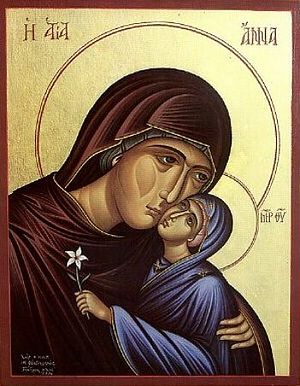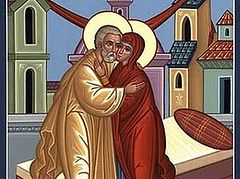Source: Hellenic News of America
 The following excerpt, from The Orthodox Veneration of the Mother of God by our modern day Saint John Maximovitch, Archbishop of Shanghai and San Francisco, is an Orthodox Christian response to the Roman Catholic belief of the Immaculate Conception of the Virgin Mary. The Immaculate Conception, the belief that the Mother of God was conceived and born without sin, was declared a dogma of the Catholic Church by Pope Pius IX on December 8, 1854. The feast of the Immaculate Conception is a holy day of obligation for Roman Catholics.
The following excerpt, from The Orthodox Veneration of the Mother of God by our modern day Saint John Maximovitch, Archbishop of Shanghai and San Francisco, is an Orthodox Christian response to the Roman Catholic belief of the Immaculate Conception of the Virgin Mary. The Immaculate Conception, the belief that the Mother of God was conceived and born without sin, was declared a dogma of the Catholic Church by Pope Pius IX on December 8, 1854. The feast of the Immaculate Conception is a holy day of obligation for Roman Catholics.
Orthodox Christians, on the other hand, do not subscribe to the Immaculate Conception. Therefore, we do not have a feast day for it either. We do however have an important feast on the following day, December 9, on which we celebrate the Conception of the Theotokos by Saint Anna. There is a difference, a profound one, for Orthodox Christians.
What I share here from Saint John is not meant to hurl insults, discrimination, hatred, or any of the sort. I just want to clarify some things. Saint John reposed in 1966 and is considered one of the greatest Orthodox Saints in the 20th century. His writing simply clarifies the Orthodox position, which is not the same as the Roman Catholic. If anything sounds a little harsh from what he says, I bring to mind 2 things. First, Saint John in his book cites Roman Catholic Saints in helping to explain the Orthodox position: Thomas Aquinas and Bernard of Clarivaux. Aquinas and Bernard are not Saints of the Orthodox Church, but they were pillars of the Roman Catholic Church during the medieval period. Both Aquinas and Bernard of Clairvaux decisively rejected the teaching of the Immaculate Conception however, seeing it as something foreign to the beliefs of the ancient Church. Secondly, Saint John Maximovitch was not a hateful fanatic out to hurt people. He was actually a bishop in Paris for a period of time and was loved even by French Roman Catholics. In fact, there were Catholic clergy who were encouraging their flock at the time to look to John as a living Saint in their midst.
We Orthodox believe that the Panagia was conceived and born in a state of sin since she is a human being just like the rest of us. Only Christ was free of sin. We do venerate the Panagia highly though. She is the holiest of all the Saints and is like a member of our families. We do believe that the Panagia committed no actual personal sins. We believe that both through God’s grace and her free cooperation with God’s grace – both go together- she committed no sin. We believe she overcame every temptation to sin and thus remained ever pure, even in her mind and soul. There is a synergy, a cooperation, going on between God and the Panagia. She exercises her free will to respond to God.
————-
The teaching of the complete sinlessness of the Mother of God (1) does not correspond to Sacred Scripture, where there is repeatedly mentioned the sinlessness of the “One Mediator between God and man, the man Jesus Christ” (1 Tim. 2:5); “and in Him is no sin” (1 John 3:5); “Who did no sin, neither was guile found in His mouth.” (1 Peter 2:22); “One that hath been in all points tempted as we are, yet without sin” (Heb. 4:15); “Him who knew no sin, He made to be sin on our behalf” (II Cor. 5:21). But concerning the rest of men it is said, Who is pure of defilement? No one who has lived a single day of his life on earth (Job 14:4). God commendeth His own love toward us in that, while we were yet sinners, Christ died for us…If, while we were enemies, we were reconciled to God through the death of His Son, much more, being reconciled, shall we be saved by His life” (Rom. 5:8-10).
(2) This teaching contradicts also Sacred Tradition, which is contained in numerous Patristic writings, where there is mentioned the exalted sanctity of the Virgin from Her very birth, as well as Her cleansing by the Holy Spirit at Her conception of Christ, but not at Her own conception by Anna. “There is none without stain before Thee, even though his life be but a day, save Thou alone, Jesus Christ our God, Who didst appear on earth without sin, and through Whom we all trust to obtain mercy and remission of sins.” (St. Basil the Great, Third Prayer of Vespers of Pentecost.) “But when Christ came through a pure, virginal, unwedded, God-fearing, undefiled Mother without wedlock and without father, and inasmuch as it befitted Him to be born, He purified the female nature, rejected the bitter Eve and overthrew the laws of the flesh” (St. Gregory the Theologian, “In Praise of Virginity”). However, even then, as Sts. Basil the Great and John Chrysostom speak of this, She was not placed in the state of being unable to sin, but continued to take care of Her salvation and overcame all temptations (St. John Chrysostom, Commentary on John, Homily 85; St. Basil the Great, Epistle 160).
(3) The teaching that the Mother of God was purified before Her birth, so that from Her might be born the Pure Christ, is meaningless; because if the Pure Christ could be born only if the Virgin might be born pure, it would be necessary that Her parents also should be pure of original sin, and they again would have to be born of purified parents, and going further in this way, one would have to come to the conclusion that Christ could not have become incarnate unless all His ancestors in the flesh, right up to Adam inclusive, had been purified beforehand of original sin. But then there would not have been any need for the very Incarnation of Christ, since Christ came down to earth in order to annihilate sin.
(4) The teaching that the Mother of God was preserved from original sin, as likewise the teaching that She was preserved by God’s grace from person sins, makes God unmerciful and unjust; because if God could preserve Mary from sin and purify Her before Her birth, why does He not purify other men before their birth, but rather leaves them in sin? It follows likewise that God saves men apart from their will, predetermining certain ones before their birth to salvation.
(5) This teaching, which seemingly has the aim of exalting the Mother of God, in reality completely denies all Her virtues. After all, if Mary, even in the womb of Her mother, when She could not even desire anything either good or evil, was preserved by God’s grace from every impurity, and then by that grace was preserved from sin even after Her birth, then in what does Her merit consist? If She could have been placed in the state of being unable to sin, and did not sin, then for what did God glorify Her? If She, without any effort, and without having any kind of impulses to sin, remained pure, then why is She crowned more than everyone else? There is no victory without an adversary.
The righteousness and sanctity of the Virgin Mary were manifested in the fact that She, being “human with passions like us,” so loved God and gave Herself over to Him, that by Her purity She was exalted high above the rest of the human race. For this, having been foreknown and forechosen, She was vouchsafed to be purified by the Holy Spirit Who came upon Her, and to conceive of Him the very Saviour of the world. The teaching of the grace-given sinlessness of the Virgin Mary denies her victory over temptations; from a victor who is worthy to be crowned with crowns of glory, this makes Her a blind instrument of God’s Providence.
It is not an exaltation and greater glory, but a belittlement of her, this “gift” which was given Her by Pope Pius IX and all the rest who think they can glorify the Mother of God by seeking out new truths. The Most Holy Mary has been so much glorified by God Himself, so exalted is Her life on earth and Her glory in heaven, that human inventions cannot add anything to Her honor and glory. That which people themselves invent only obscures Her Face from their eyes. Brethren, take heed lest there shall be any one that maketh spoil of you through philosophy and vain deceit, after the tradition of men, after the rudiments of the world, and not after Christ, wrote the Apostle Paul by the Holy Spirit (Col. 2:18).
Such a “vain deceit” is the teaching of the Immaculate Conception by Anna of the Virgin Mary, which at first sight exalts, but in actual fact belittles Her. Like every lie, it is a seed of the “father of lies” (John 8:44), the devil, who has succeeded by it in deceiving many who do not understand that they blaspheme the Virgin Mary. Together with it there should also be rejected all the other teaching which have come from it or are akin to it. The striving to exalt the Most Holy Virgin to an equality with Christ ascribing to her maternal tortures at the Cross an equal significance with the sufferings of Christ, so that the Redeemer and “Co-Redemptress” suffered equally, according to the teaching of the Papists, or that “the human nature of the Mother of God in heaven together with the God-Man Jesus jointly reveal the full image of man” (Archpriest S. Bulgakov, The Unburnt Bush, p. 141) – is likewise a vain deceit and a seduction of philosophy. In Christ Jesus there is neither male nor female (Gal. 3:39), and Christ has redeemed the whole human race; therefore at His Resurrection equally did “Adam dance for joy and Eve rejoice” (Sunday Kontakia of the First and Third Tones), and by His Ascension did the Lord raise up the whole of human nature.
Likewise, that the Mother of God is a “complement of the Holy Trinity” or a “fourth Hypostasis”; that “the Son and the Mother are a revelation of the Father through the second and Third Hypostases”; that the Virgin Mary is a “creature, but also no longer a creature” – all this is the fruit of vain, false wisdom which is not satisfied with what the Church has held from the time of the Apostles, but strives to glorify the Holy Virgin more than God glorified Her.
Thus are the words of St. Epiphanius of Cyprus fulfilled: “Certain senseless ones in their opinion about the Holy Ever-Virgin have striven and are striving to put Her in place of God” (St. Epiphanius, “Against the Antidikomarionites”). But that which is offered to the Virgin in senselessness, instead of praise of Her turns out to be blasphemy; and the All-Immaculate One rejected the lie, being the Mother of Truth (John 14:6).




The Oldbelievers of Russia also give witness to this fact. The difference is the approach of original sin and original guilt and original stain and not the stainlessness of the Mostholy and Allimmaculate Theotkos
The Ark was instructed to be crafted from gold, a symbol of its purity. Christ, having no mortal father, derives all of His human nature from a single source: the virgin Mary. Since Jesus was perfect in both His divine nature and His human nature, it follows naturally that the human from which He was imparted His human nature ought to be a perfect human never sullied by the taint of sin. This preservation was not necessary for all of Jesus' lineage because He only shared His very body and all of His human nature with one single mortal being: Mary.
(5) The teaching ... (2/4)
(3) Mary was not conceived sinless because it was necessary, but because it was fitting. Christ shared his body in utero with the Theotokos, including his blood. As Catholics we see that Christ is the Logos fulfillment of the Mosaic Laws inscribed on the stone tablets, the High Priest fulfillment of Aaron's staff, and the Bread of Heaven fulfillment of the Mana, all kept within the Ark of the Covenant. The virgin mother contained the Word of God, the High Priest, and the Bread of Heaven inside of ... (1/4)